Mini 5 Pro vs. Mini 4 Pro: Which Should You Buy?
DJI has raised the bar again with the release of the Mini 5 Pro, but is it worth upgrading from the already impressive Mini 4 Pro? This comprehensive comparison breaks down everything you need to know about these sub-250g drones, from camera capabilities and flight performance to smart features and value proposition. Whether you’re a content creator, hobbyist, or professional looking for the perfect portable drone, this guide will help you make an informed decision.
Mini 5 Pro vs. Mini 4 Pro: Key Specifications
Before diving into the details, let’s look at how these two compact drones stack up against each other in terms of core specifications. The table below highlights the most important differences to consider when choosing between the Mini 5 Pro and Mini 4 Pro.
| Specification | DJI Mini 5 Pro | DJI Mini 4 Pro |
| Weight | 249.9g (±4g) | |
| Camera Sensor | 1-inch CMOS, 50MP | 1/1.3-inch CMOS, 48MP |
| Video Resolution | 4K/120fps, 10-bit | 4K/100fps, 10-bit |
| Gimbal Rotation | 225° rotation | True vertical shooting |
| Flight Time | 36 minutes | 34 minutes |
| Obstacle Sensing | Omnidirectional + LiDAR | Omnidirectional |
| Low-light Performance | 1 lux | 15 lux |
| Transmission | O4+ | O4 |
| Internal Storage | 42GB | 2GB |
| Starting Price | $769 | $649 |
Design Differences: Build Quality and Physical Changes
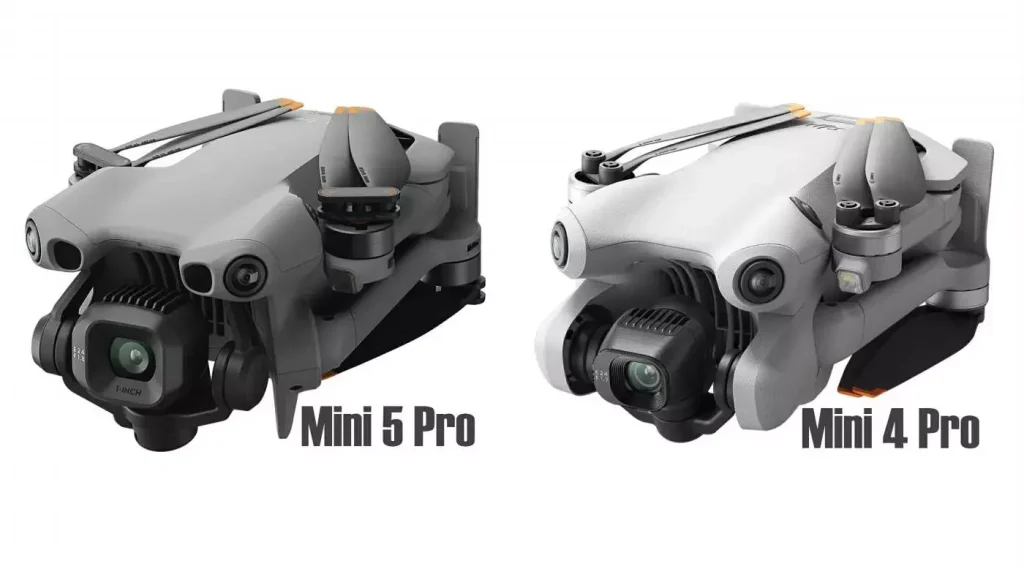
At first glance, the Mini 5 Pro and Mini 4 Pro look remarkably similar, but there are subtle yet important differences in their design and build quality:
Size and Weight
The Mini 5 Pro is slightly larger than its predecessor, measuring 157 × 95 × 68 mm when folded (compared to the Mini 4 Pro’s 148 × 94 × 64 mm). This small increase accommodates the larger 1-inch sensor and additional hardware.
While both drones are marketed as sub-250g, the Mini 5 Pro officially weighs 249.9g ±4g, meaning some units may exceed the 250g threshold. This could have regulatory implications in certain regions, though both remain C0-class drones in the EU.
Visual Differences
The Mini 5 Pro comes in a darker shade of gray compared to the Mini 4 Pro. The most noticeable external difference is at the front of the drone, where the Mini 5 Pro features a forward-facing LiDAR sensor nestled between the vision sensors.
Another practical design improvement in the Mini 5 Pro is the ability to power on and off by simply folding or unfolding the right rear arm—a small but convenient feature that streamlines the pre-flight process.
Camera Capabilities: Image Quality and Video Performance
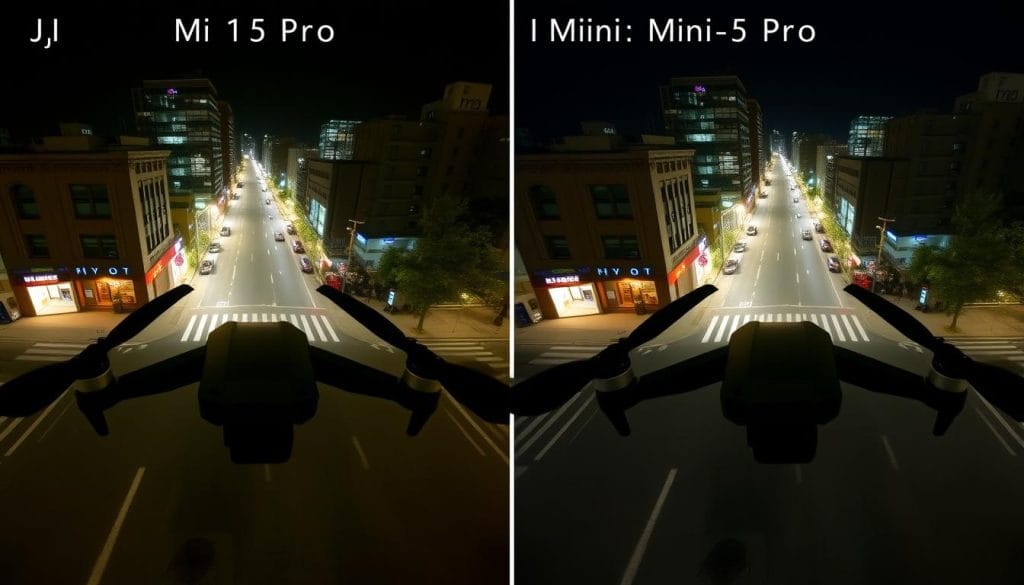
The camera system is where the Mini 5 Pro truly distinguishes itself from the Mini 4 Pro, with significant upgrades that professional content creators will appreciate:
Sensor Size
The Mini 5 Pro features a 1-inch CMOS sensor—a substantial upgrade from the Mini 4 Pro’s 1/1.3-inch sensor. This larger sensor captures more light, resulting in better dynamic range, improved low-light performance, and reduced noise in challenging conditions.
Video Capabilities
Both drones shoot 4K/60fps HDR video, but the Mini 5 Pro pushes the envelope with 4K/120fps slow-motion (compared to the Mini 4 Pro’s 4K/100fps). The Mini 5 Pro also delivers up to 14 stops of dynamic range and records 10-bit video using H.265 encoding even in normal color mode.
Low-Light Performance
The Mini 5 Pro significantly outperforms the Mini 4 Pro in low-light conditions. Its maximum ISO in normal mode is 12800 (compared to 6400 on the Mini 4 Pro), while in D-Log M and HLG color modes, the maximum ISO is doubled to 3200 (from 1600 on the Mini 4 Pro).
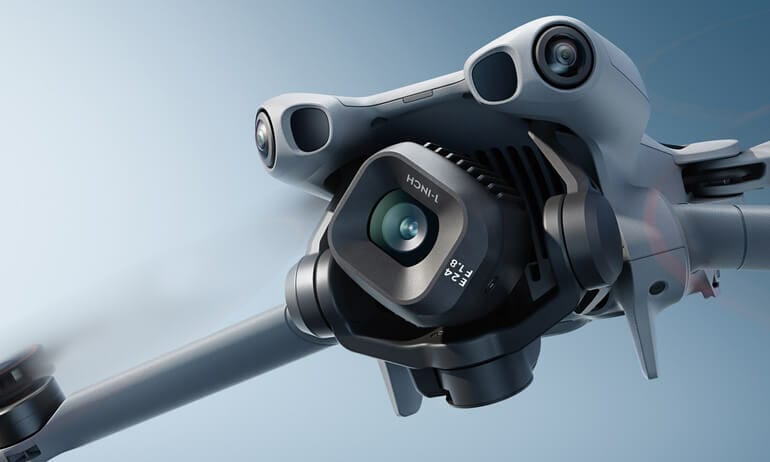
Gimbal Innovations
The Mini 5 Pro introduces a 225° rotating gimbal, a significant upgrade from the Mini 4 Pro’s more limited range. This enhanced flexibility allows for more creative angles and dynamic camera movements. Both drones support true vertical shooting for social media content, but the Mini 5 Pro’s expanded gimbal rotation offers greater creative freedom.
Another notable addition to the Mini 5 Pro is the 48mm Med-Tele mode (2x zoom), which helps subjects stand out more prominently without having to fly dangerously close to them. While this is essentially a digital zoom with some computational photography enhancements, it adds valuable versatility to your shooting options.
Ready for Professional-Quality Aerial Photography?
The Mini 5 Pro’s 1-inch sensor and advanced gimbal make it the perfect choice for creators who demand superior image quality, especially in challenging lighting conditions.
Safety Features: Obstacle Avoidance and Night Flying
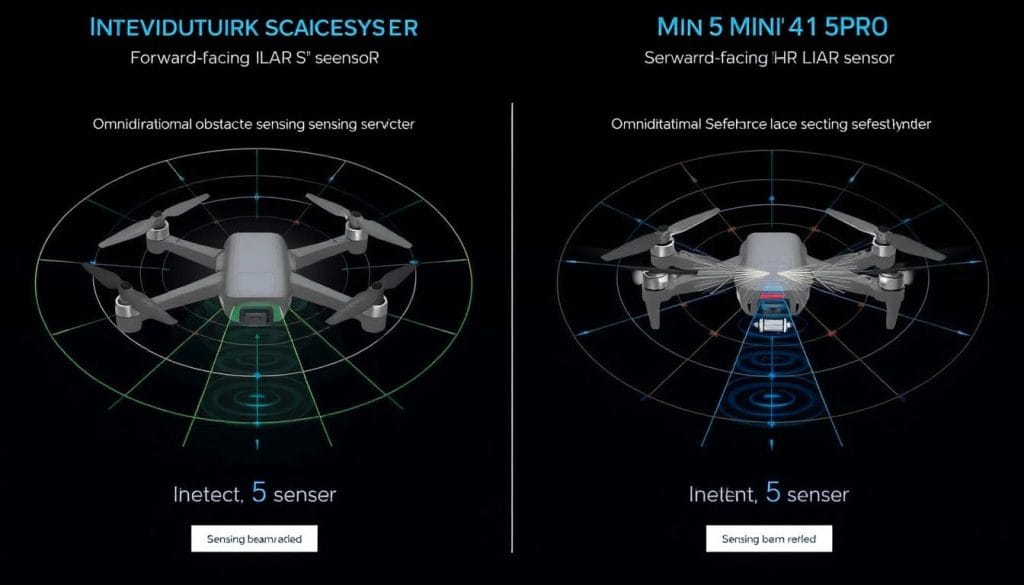
Safety is a crucial consideration for drone pilots, and the Mini 5 Pro brings significant advancements in this area:
Obstacle Sensing
Both drones feature omnidirectional obstacle sensing with binocular vision systems, but the Mini 5 Pro adds forward-facing LiDAR. This addition enables more precise distance measurement and better performance in challenging conditions.
The Mini 5 Pro’s forward sensors can detect obstacles from 0.5-18 meters away at flight speeds up to 15 m/s, compared to the Mini 4 Pro’s 12 m/s limit. Similar improvements apply to the backward, lateral, upward, and downward sensors, making the Mini 5 Pro more responsive and safer overall.
Low-Light Performance
The most significant safety upgrade is the Mini 5 Pro’s ability to operate in extremely low light conditions. Its sensors can function in environments as dim as 1 lux, compared to the Mini 4 Pro’s 15 lux minimum requirement.
This “nightscape omnidirectional obstacle sensing” makes the Mini 5 Pro much more capable for twilight, dawn, and urban night flying. The LiDAR system provides reliable forward obstacle detection even when the vision system becomes ineffective due to darkness.
Return-to-Home Capabilities
The Mini 5 Pro introduces next-generation Smart RTH (Return to Home) functionality. In well-lit conditions, it memorizes flight paths, enabling quick takeoffs and safe returns even without satellite signals. While the Mini 4 Pro has Advanced RTH that can plan safe routes back to the home point, the Mini 5 Pro’s system is more sophisticated and reliable, especially in challenging environments.
Flight Performance: Speed, Agility, and Tracking
When it comes to flight performance, the Mini 5 Pro offers several improvements over its predecessor:
Flight Time
The Mini 5 Pro offers 36 minutes of flight time with the standard Intelligent Flight Battery, compared to the Mini 4 Pro’s 34 minutes. With the Intelligent Flight Battery Plus (not available in all regions), the Mini 5 Pro can stay airborne for up to 52 minutes, while the Mini 4 Pro tops out at 39 minutes.
Speed and Agility
The Mini 5 Pro has a maximum forward flight speed of 18 m/s in Sport mode, compared to the Mini 4 Pro’s 16 m/s. Even more impressive is the Mini 5 Pro’s ascent speed in Sport mode, which at 10 m/s is double that of the Mini 4 Pro. This makes the newer model more responsive and capable of capturing fast-moving subjects.
Wind Resistance
The Mini 5 Pro can withstand wind speeds of up to 12 m/s, an improvement over the Mini 4 Pro’s 10.7 m/s tolerance. It can also take off at altitudes up to 6,000m, compared to the Mini 4 Pro’s 4,000m limit, making it more versatile for mountain and high-altitude filming.
Subject Tracking
Both drones feature ActiveTrack 360°, but the Mini 5 Pro’s version has been significantly enhanced:
- The Mini 5 Pro can track subjects at speeds up to 15 m/s in open areas, compared to the Mini 4 Pro’s more limited capabilities.
- The newer model intelligently detects different scenarios and can automatically select between Cycling or Standard tracking modes for optimal framing.
- In complex environments, the Mini 5 Pro can switch to rear tracking mode to maintain subject focus while navigating obstacles more effectively.
- The tracking algorithms have been refined to balance speed, agility, and safety, resulting in smoother footage and more reliable performance.
Transmission System
The Mini 5 Pro features DJI’s O4+ video transmission system, an upgrade from the Mini 4 Pro’s O4 system. While both offer a maximum transmission distance of 10km (CE) or 20km (FCC), the O4+ system provides stronger signal quality, enhanced anti-interference capabilities, and more stable, reliable live feeds.
Storage and Connectivity
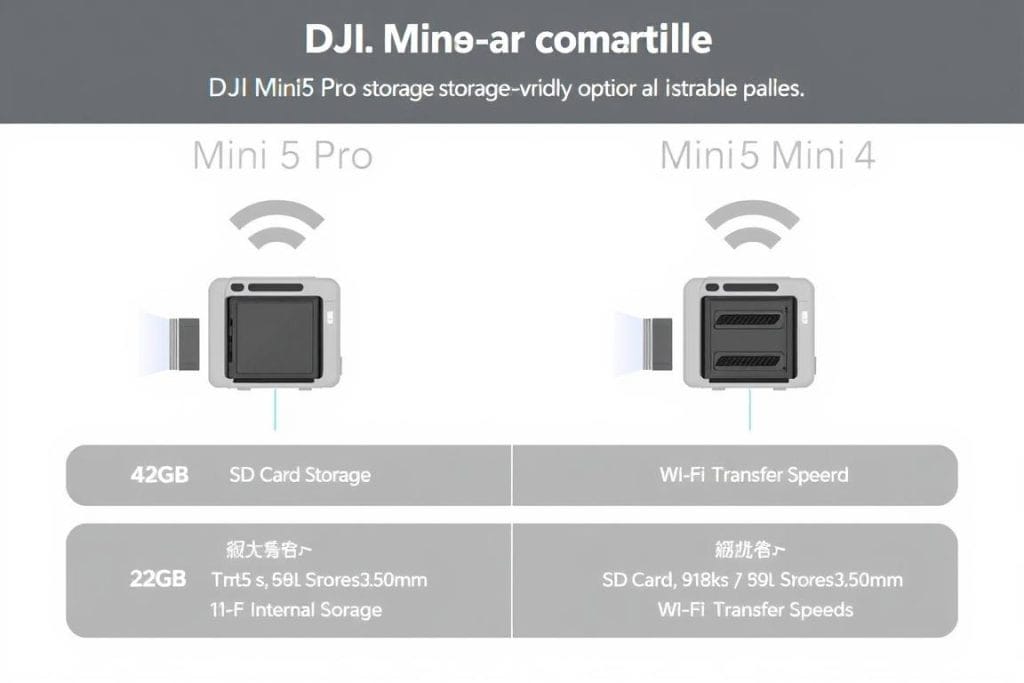
The Mini 5 Pro brings significant improvements in storage capacity and data transfer speeds:
Internal Storage
One of the most practical upgrades in the Mini 5 Pro is its 42GB of onboard storage—a massive increase from the Mini 4 Pro’s 2GB. This means you can continue shooting even if you forget your memory card or it becomes full during a flight.
Both drones support microSD cards for expandable storage, but the Mini 5 Pro can accommodate cards up to 1TB, while the Mini 4 Pro tops out at 512GB recommended capacity.
File Transfer
The Mini 5 Pro supports high-speed file transfers at up to 100MB/s with Wi-Fi, more than three times faster than the Mini 4 Pro’s 30MB/s maximum. This makes downloading footage to your devices much quicker and more convenient, especially when working with large 4K video files.
This improved connectivity makes the Mini 5 Pro more efficient for professional workflows where time is valuable and quick turnaround is essential.
Compatible Accessories and Controllers
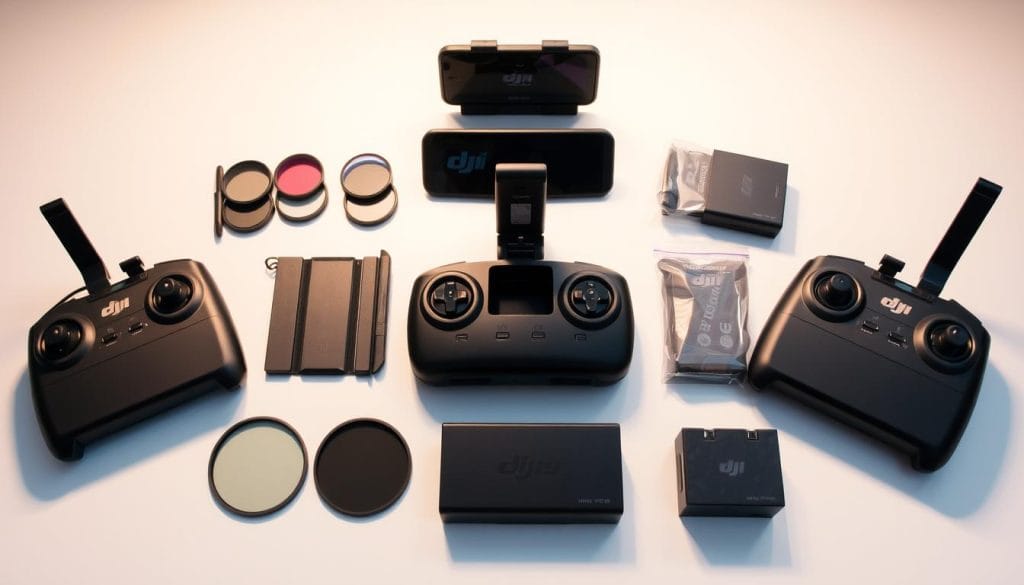
Both drones are compatible with a range of DJI controllers and accessories:
Controllers
The Mini 5 Pro and Mini 4 Pro support:
- DJI RC 2 smart controller with built-in 5.5-inch high-bright screen
- DJI RC Pro 2 with built-in 7.02-inch high-bright screen
- DJI RC-N3, which requires a separate smart device
The Mini 4 Pro is also compatible with the DJI RC-N2, while at launch, the Mini 5 Pro does not appear to support DJI’s FPV ecosystem, unlike the Mini 4 Pro.
Other Accessories
Both drones work with ND filter sets and Two-way Charging Hubs for multiple batteries. Notably, the Mini 5 Pro Fly More Combo includes the ND filter set, while the Mini 4 Pro Fly More Combo does not.
The Mini 5 Pro Two-way Charging Hub offers greater efficiency than its predecessor. When using the DJI 65W Portable Charger, it takes about 46 minutes to fully charge a single battery and 115 minutes for three batteries. In contrast, the Mini 4 Pro’s charging hub with a 30W charger takes 58 minutes for one battery and three hours for three batteries.
Price and Value Proposition
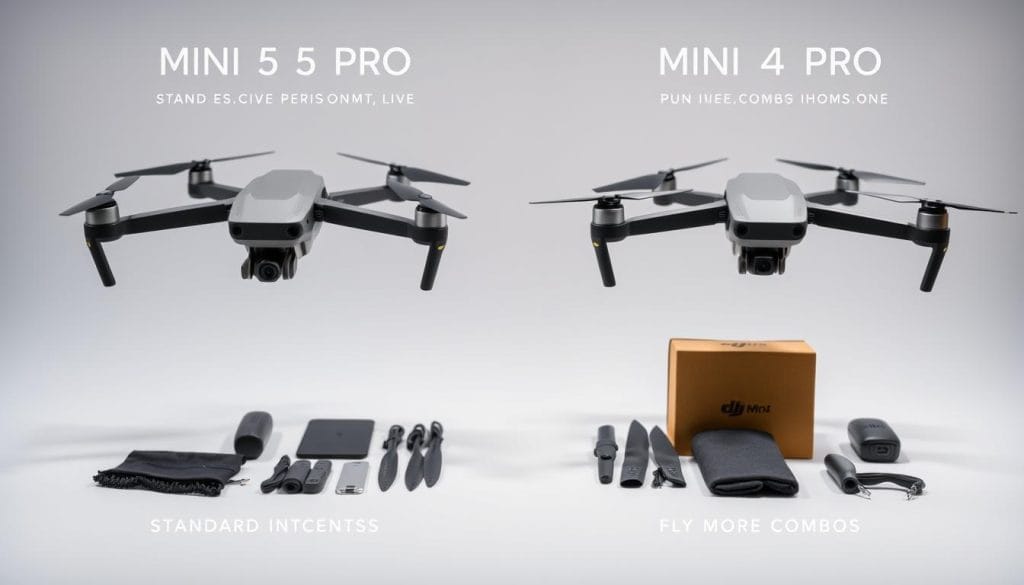
| Package | DJI Mini 5 Pro | DJI Mini 4 Pro |
| Standard (RC-N3) | $769 | $649 |
| Standard (RC 2) | $959 | $849 |
| Fly More Combo (RC 2) | $1,159 | $1,049 |
The Mini 5 Pro commands a premium of approximately $100-120 over equivalent Mini 4 Pro packages. Is this price difference justified? Let’s break down the value proposition:
Mini 5 Pro Value Advantages
- 1-inch sensor with superior low-light performance
- Forward-facing LiDAR for enhanced safety
- 225° rotating gimbal for creative flexibility
- 42GB internal storage vs. 2GB
- Faster file transfers (100MB/s vs. 30MB/s)
- ND filters included in Fly More Combo
- Better wind resistance and higher altitude capability
Mini 4 Pro Value Advantages
- Lower price point ($100-120 less)
- Guaranteed sub-250g weight
- FPV ecosystem compatibility
- Still offers excellent image quality for most conditions
- Nearly identical flight time (34 vs. 36 minutes)
- Same maximum transmission distance
- Still supports true vertical shooting
For content creators who frequently shoot in challenging lighting conditions or require the highest image quality possible from a sub-250g drone, the Mini 5 Pro’s premium is easily justified. However, casual users who primarily fly in good lighting conditions may find the Mini 4 Pro offers better value.
Conclusion: Which Drone Should You Buy?

After comparing all aspects of the Mini 5 Pro and Mini 4 Pro, here are our recommendations for different user types:
Choose Mini 5 Pro If You Are:
- A professional content creator who needs the best image quality
- Someone who frequently shoots in low-light conditions
- A filmmaker who values creative flexibility with the 225° gimbal
- A pilot who often flies in challenging environments
- Someone who needs substantial onboard storage
- A user who wants the most future-proof option
Choose Mini 4 Pro If You Are:
- A hobbyist or casual user on a tighter budget
- Someone who primarily flies in good lighting conditions
- A pilot concerned about staying strictly under 250g
- A user who wants FPV ecosystem compatibility
- Someone who finds the Mini 4 Pro’s features sufficient
- A beginner looking for an excellent entry point
Both the Mini 5 Pro and Mini 4 Pro are exceptional drones that pack impressive capabilities into sub-250g packages. The Mini 5 Pro represents a significant upgrade in image quality, obstacle avoidance, and creative flexibility, justifying its higher price for professionals and serious enthusiasts. However, the Mini 4 Pro remains an excellent option that delivers outstanding performance at a more accessible price point.
Your choice ultimately depends on your specific needs, budget, and how you plan to use your drone. Whichever model you select, you’ll be getting one of the most capable ultralight drones on the market today.
Ready to Take Your Aerial Photography to New Heights?
Whether you choose the cutting-edge Mini 5 Pro or the excellent value Mini 4 Pro, it’s time to elevate your content creation.
Frequently Asked Questions
Is the Mini 5 Pro worth upgrading from the Mini 4 Pro?
If you already own a Mini 4 Pro, upgrading to the Mini 5 Pro is most worthwhile if you: 1) frequently shoot in low-light conditions where the 1-inch sensor would make a significant difference, 2) need the enhanced creative flexibility of the 225° rotating gimbal, or 3) value the improved obstacle avoidance with LiDAR for safer night flying. For casual users who primarily fly in good lighting, the upgrade may be less essential.
Does the Mini 5 Pro weigh under 250g?
DJI lists the Mini 5 Pro’s weight as 249.9g ±4g, meaning some units may exceed the 250g threshold. If staying strictly under 250g is important for regulatory compliance in your region, this is worth considering. The Mini 4 Pro is guaranteed to be under 249g.
Can I use my Mini 4 Pro accessories with the Mini 5 Pro?
Many accessories are compatible across both models, including the DJI RC 2, RC Pro 2, and RC-N3 controllers. However, the batteries and charging hubs are model-specific and not interchangeable. The Mini 5 Pro uses a new Two-way Charging Hub that offers faster charging times than the Mini 4 Pro’s hub.
How much better is the Mini 5 Pro’s camera compared to the Mini 4 Pro?
The Mini 5 Pro’s 1-inch sensor represents a significant upgrade over the Mini 4 Pro’s 1/1.3-inch sensor, especially in challenging lighting conditions. You’ll notice better dynamic range, improved low-light performance, and reduced noise. For daytime shooting in good lighting, the difference is less pronounced, though still noticeable in the details and color rendition.
Is the Mini 5 Pro available worldwide?
The Mini 5 Pro has some regional availability restrictions. It’s not officially sold in the US due to recent DJI restrictions. Customers in other regions, including Europe, Asia, and Australia, can purchase it through official channels.
